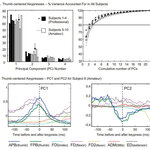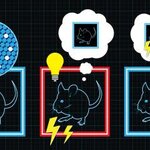Neuroscience

New research just out in the
journal Science Translational Medicine opens
the door for treatments capable of stopping Alzheimer’s
disease (AD) before its first symptoms, that is to say before crucial
damage occurs. In fact, while AD is a devastating disorder, it is also an extremely
slow one; it takes more than 10 years for the first symptoms to appear making
this preclinical period (pre-symptoms) the ideal time to intervene.
And now a study from the Hertie Institute for Clinical Brain Research in Tübingen and the
Hospital de Santo António-CHP, Porto, Portugal could be the
first step…

Near-death experiences may have found a new grounding in science.
Whether and how the dying brain is capable of generating conscious activity has been vigorously debated but the near-death experiences reported by cardiac arrest survivors worldwide may be verifiable, according to a new paper.
Approximately 20 percent of cardiac arrest survivors report having had a near-death experience during clinical death. These visions and perceptions have been called "realer than real" but it remains unclear whether the brain is capable of such activity after cardiac arrest.
A new paper found that shortly…

There is a phenomenon in speech called coarticulation, in which certain sounds are produced differently depending on the sounds that come before or after them.
For example, though the letter n is usually pronounced with the tongue pressed near the middle of the mouth's roof (as in the word "ten") but it's pronounced with the tongue forward when it's followed by a –th, as in tenth).
A decade ago, researchers discovered that coarticulation extends to a different kind of communication - American Sign Language. Knowing that hand movements could be affected according to where they fit in during…

Cocaine use may cause profound metabolic changes which can result in dramatic weight gain during recovery, a distressing phenomenon that can lead to relapse - the reason is because chronic cocaine use may reduce the body's ability to store fat, the authors of a new paper suggest.
It is widely believed that cocaine suppresses the appetite and that the problematic weight gain during rehabilitation was a result of patients substituting food for drugs.
The scholars scanned over sixty men to evaluate body composition, diets and eating behaviours. Half of the men in the sample had a…
Oxytocin, the warm, fuzzy miracle hormone that promotes feelings of love, social bonding and well-being, isn't quite as simple as those miracle-cure-of-the-week newspaper stories want you to believe.
It turns out that correlation is not causation, which surprises no one in science, and that oxytocin is also linked to emotional pain. Maybe someone will call this other form Dark Oxytocin, because stressful social situations continue to haunt you and and even trigger fear and anxiety in the future, you can blame hormones. And putting Dark in front of mysterious things is popular.
Oxytocin…

Fibromyalgia, widespread general muscle pain and fatigue, has no known causes or effective treatments but small-fiber polyneuropathy (SFPN) has a clear pathology and is known to be caused by specific medical conditions, some of which can be treated and sometimes cured.
In a small group of patients with fibromyalgia, about half were found to have damage to nerve fibers in their skin and other evidence of small-fiber polyneuropathy.
Though fibromyalgia is recognized by the National Institutes of Health, the symptoms vary widely and it is used more as a blanket term.…

A Toronto patient has become the second known person to have acquired synesthesia as a result of a brain injury, in this case a stroke.
Synesthesia is a neurological condition in which people experience more than one sense at the same time. They may "see" words or numbers as colors, hear sounds in response to smells or feel something in response to sight. Most synesthetes are born with the condition. Famous authors and artists include composer Franz Liszt, painter Vasily Kandinsky, singer-songwriter Billy Joel and author Vladimir Nabakov.
About nine months after suffering a stroke, the…

At a young age, kids learn that the cookies are still there, even though they have been placed in a jar. And they learn that a car driven into a tunnel will reappear on the other side.
The ability to represent and to track the trajectory of objects which are temporally out of sight is important in many aspects - and also cognitively demanding. In non-human primates, only the great apes have shown convincing abilities there.
Alice Auersperg and her team from the University of Vienna and Oxford have shown that "object permanence" abilities in the Goffin Cockatoo (Cacatua goffini)…

A "structure-based" approach to drug design has led to identification of compounds with the potential to delay or treat Alzheimer's disease, and possibly Parkinson's, Lou Gehrig's disease and other degenerative disorders.
Structure-based drug design, in which the physical structure of a targeted protein is used to help identify compounds that will interact with it, has already been used to generate therapeutic agents for a number of infectious and metabolic diseases.
Degenerative brain disorders such as the ones listed above are marked by harmful, elongated, rope-like structures known…

False memories implanted in mice show
how easily it is to manipulate recall of events.
Image credit: Collective next- taken from the press
release (25/7/13): False memories incepted into the mouse brain shed light on
the neural basis of the human phenomenon. Red and blue boxes represent two separate environments.
Memory is a phenomenon like no other. The ability to recall
events which occurred in the past helps cognitive beings to anticipate the
outcomes of similar happenings and allows the build up of experience which can
be hugely informative. Scientists have identified the ‘engram-…